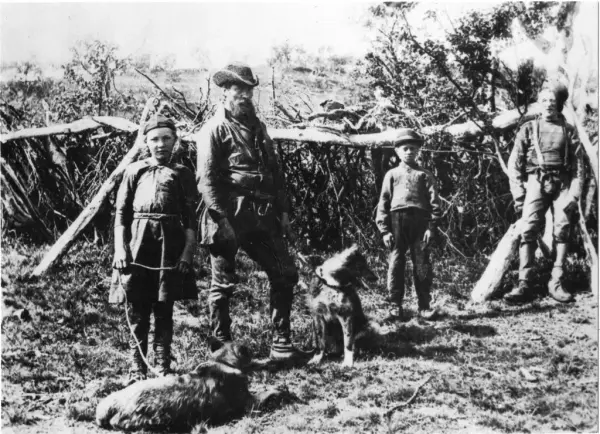JUHTIJEALMETJIJSTIE ARRAHALMETJIDIE - From nomadism to permanent settlements
The reindeer formed the basis of the Sámi way of life. The families followed the reindeer through the seasons, and access to grazing determined where they settled. The reindeer provided food and raw materials. In the years 1910–1935, the Sámi families in the Røros region became sedentary. This led to major changes for the Røros Sámi population in terms of lifestyle, social relationships, language, material culture and diet.
Up to the first years of the 20th century, the Sámi in the Røros Sámi area were nomads who followed the reindeer herd around the different seasonal pastures. The families returned to the same dwellings and grazing lands in an annual cycle, wherever the grazing for the animals allowed it. Reindeer were used as draught and pack animals and provided meat and milk, as well as raw materials for clothing, shoes and tools. This made the Sámi families self-sufficient. Two to four families would stay together through the summer, herding and milking the reindeer. In winter time, several families might stay together to ease the work with the herd.
In the 20th century, the Sámi way of life was transformed. The changes had great societal and social consequences. One major change came with the abandonment of diary farming, and greater emphasis was placed on meat production for sale. The reduction in reindeer grazing land and the need for money to pay compensation for damage to pasture land were contributory factors.
Another major change was that the reindeer herding families became sedentary. Some acquired mountain farms where women, children and old people did the work. The herdsmen stayed with their herds far below the families’ permanent home, and work with the reindeer demanded ever more physical endurance. The herding work thus became male-dominated, and the men were away for long periods.
Many of the objects on display are connected with the nomadic way of life. The change to permanent dwellings brought an end to milk production and these objects fell out of use.
Photos (from left)
1. An enclosure in Tjerrålia in Ridalen, ca. 1900. The reindeer cows were milked in the enclosure.
2. Reindeer herders with their herd in Essand reindeer grazing district, now Saanti Sijte.
3. Many Sámi families purchased or built mountain farms when they gave up the nomadic life. Some also engaged in farming for a while, as well as reindeer herding. The picture is from Svukuriset in Engerdal, the farm which Daniel Mortenson bought in 1905.
4. The married couple Marit Andersdatter Holm and Morten Mortensen Kant had to give up reindeer herding. They settled at Øra in Røros in 1920.
5. Reindeer train at the head of the herd in Tolgen district, now Svahken Sijte. Reindeer and sleighs loaded with food and equipment were tethered together in a long chain. Each family might have three to five sleighs, and when several families moved together, the train could be long.
6. Jo Jonson Fjällgren’s autumn quarters in Sweden. The border between Norway and Sweden went right through the Sámi homelands. There was close contact between Norwegian and Swedish Sámi.
7. Southern Sámi with reindeer in a milking enclosure, ca. 1893. Leather clothes were still in use





